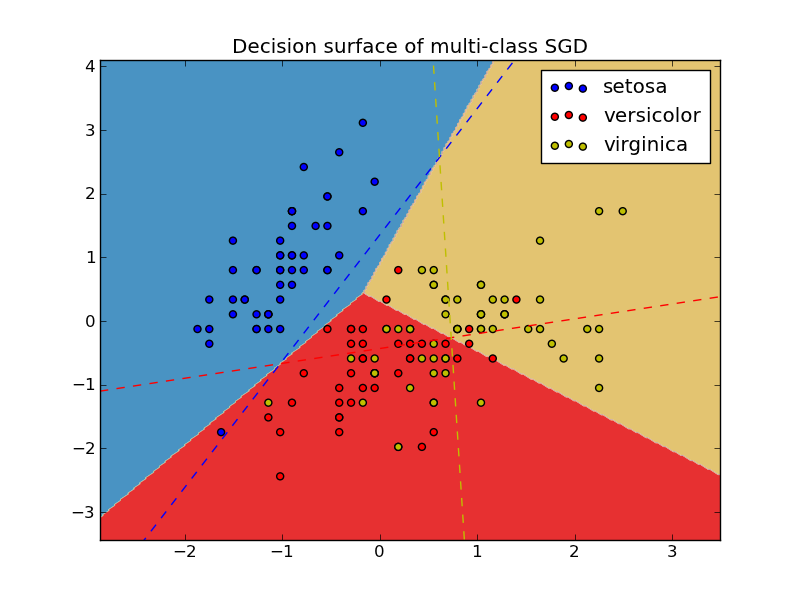Plot multi-class SGD on the iris dataset¶
Plot decision surface of multi-class SGD on iris dataset. The hyperplanes corresponding to the three one-versus-all (OVA) classifiers are represented by the dashed lines.

Python source code: plot_sgd_iris.py
print __doc__
import numpy as np
import pylab as pl
from scikits.learn import datasets
from scikits.learn.linear_model import SGDClassifier
# import some data to play with
iris = datasets.load_iris()
X = iris.data[:, :2] # we only take the first two features. We could
# avoid this ugly slicing by using a two-dim dataset
y = iris.target
colors = "bry"
# shuffle
idx = np.arange(X.shape[0])
np.random.seed(13)
np.random.shuffle(idx)
X = X[idx]
y = y[idx]
# standardize
mean = X.mean(axis=0)
std = X.std(axis=0)
X = (X - mean) / std
h = .02 # step size in the mesh
clf = SGDClassifier(alpha=0.001, n_iter=100).fit(X, y)
# create a mesh to plot in
x_min, x_max = X[:, 0].min() - 1, X[:, 0].max() + 1
y_min, y_max = X[:, 1].min() - 1, X[:, 1].max() + 1
xx, yy = np.meshgrid(np.arange(x_min, x_max, h),
np.arange(y_min, y_max, h))
pl.set_cmap(pl.cm.Paired)
# Plot the decision boundary. For that, we will asign a color to each
# point in the mesh [x_min, m_max]x[y_min, y_max].
Z = clf.predict(np.c_[xx.ravel(), yy.ravel()])
# Put the result into a color plot
Z = Z.reshape(xx.shape)
pl.set_cmap(pl.cm.Paired)
cs = pl.contourf(xx, yy, Z)
pl.axis('tight')
# Plot also the training points
for i, color in zip(clf.classes, colors):
idx = np.where(y == i)
pl.scatter(X[idx, 0], X[idx, 1], c=color, label=iris.target_names[i])
pl.title("Decision surface of multi-class SGD")
pl.axis('tight')
# Plot the three one-against-all classifiers
xmin, xmax = pl.xlim()
ymin, ymax = pl.ylim()
coef = clf.coef_
intercept = clf.intercept_
def plot_hyperplane(c, color):
def line(x0):
return (-(x0 * coef[c, 0]) - intercept[c]) / coef[c, 1]
pl.plot([xmin, xmax], [line(xmin), line(xmax)],
ls="--", color=color)
for i, color in zip(clf.classes, colors):
plot_hyperplane(i, color)
pl.legend()
pl.show()
